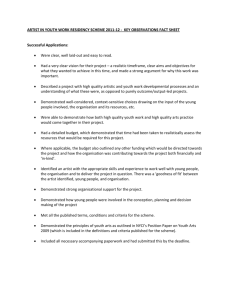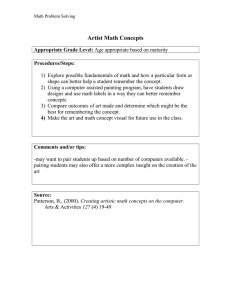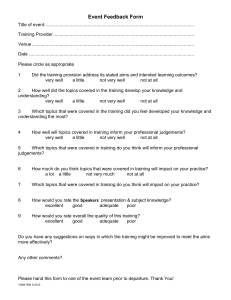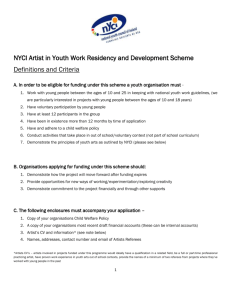PLANNING FRAMEWORK things that might help
advertisement
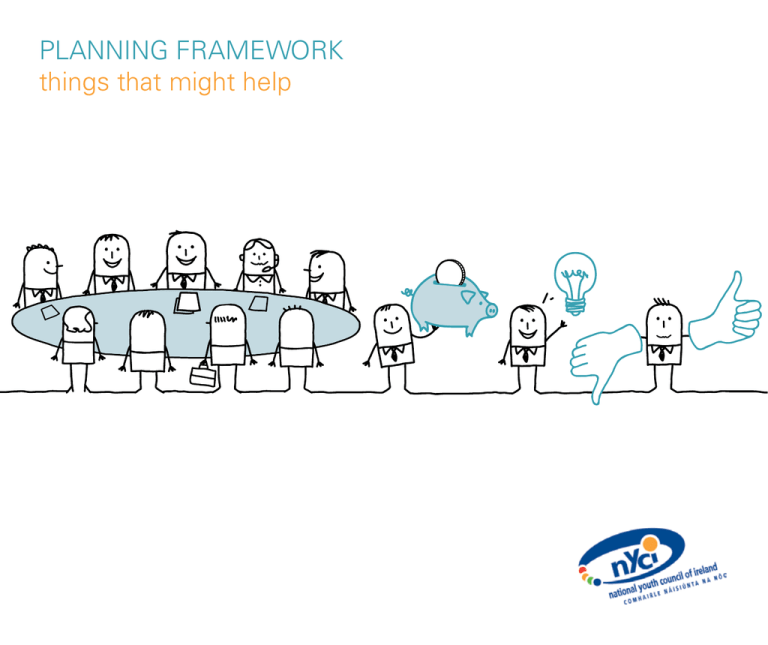
PLANNING FRAMEWORK things that might help NYCI PLANNING FRAMEWORK things that might help PLANNING FRAMEWORK PART 1: PREPARATION Name of partner / lead organisations/ artist Group Profile - names, numbers, age profile, previous arts experience (if any), background and circumstance etc. Special arrangements e.g. taster workshops, introductory visit Timeframe: Number and length of sessions Responsibilities of Artist Your planning framework is a tool by which you try clearly pin down your project so that you can manage it as well as possible and learn as much as you can from it. It is not an administration tool designed to increase your workload! Many practitioners will go through a number of drafts, refining and changing as they go. Sometimes, it is not until you see everything laid out that you realise what is going to really work and what needs some more thought – it might be the first time you realise how much work will be involved! It is better to have these realisations before the project starts than after it gets going! But, don’t forget, your plan can be flexible. Art, to be truly creative and expressive, involves responsiveness to discoveries made during the process. Changes are not necessarily a bad thing. Document it so you can explain how and why this happened when presenting the project. The most important thing is to learn from the experience. Responsibilities of Youth Worker Venue - available space, storage etc. Resources available - human, financial, material Materials to be sourced Outline here and in the section for youth worker responsibilities, everything that needs to be done, by who, by when and who’s responsible for what. Don’t presume others will do things if they are not discussed! All the things you have available to help with this project don’t leave anything out. It’s always tempting to only think of the euro amount we have to spend – but what about the admin support in your office, the photocopier that can be used to make programmes, the parent who has great pr experience, the young person who likes to make films and could film the workshops? It’s always suprising how much more support you have than you think! Everything that needs to be sourced for this project – from the obvious – like a venue! Down to the scissors and glue. Err on the side of too much detail – then you can get down to dividing up the responsibilites – and you get a more realistic sense of the workload. NYCI PLANNING FRAMEWORK things that might help PLANNING FRAMEWORK PART 2: PROJECT COSTING (Project costing may relate to some or all of the headings below) Estimated Costs • Artist Fee • Materials • Recording/documentation • Administrative costs • Venue costs (if any) • Insurance costs • Transport • Publicity • Celebration / ending to project Funding Available • Existing funds available • Contribution by parent organisation • Sponsorship • Grant Aid • Fundraising • Shortfall (if any) Again, it’s always tempting to only consider the euro amount. Think abou things that your organisation is providing and value those things and what you are contributing to the programme. A venue, youth worker support, admin support and so on – those things are also really important. Work out what they would cost if you had to pay for them and include those figures in your expenditure – both to credit your organisation for its contribution and also to be able to show funders (and to know yourself) what the project really costs. NYCI PLANNING FRAMEWORK things that might help PLANNING FRAMEWORK PART 3: PROJECT PLAN Describe what you intend to achieve through this project: How does this relate to the ethos / mission statement of the organisation? Artists' Statement: The artistic concept, how you intend to work with the group, artistic progression Project Aims: Project Objectives: Project Outcomes: Plans for documenting the Project Plans for reviewing and learning from the project Format and process of final evaluation Plans for end of project product e.g. performance, exhibition, presentation etc. This is where you can talk about how the project relates to the organisation’s overall mission – and how the project is part of that, and not separate. ‘Aims are the changes you are trying to achieve’ (Charity Evaluation Services, UK) A good youth arts project will have both artistic aims and youth work aims (such as the group will explore high quality drama process and will build teamwork, personal development and self confidence) Give consideration to both of these areas of good quality youth arts and make sure both are named. Objectives are the methods or activities by which you achieve your aims. As in your aims, make sure your objectives include both arts and youth work objectives. These are changes or results of the project – they are not outputs – ie a production, an exhibition etc. Again, there should be art and youth work outcomes – for example an appreciation of the production processes of theatre and social development skills. You will be much more likely to document your project if you plan it from the beginning. Even this planning framework is part of documenting your project. Please do try to take lots of photographs of the work in progress so that there is a record of your special project – and not just in the hearts and minds of those who took part! How will you make sure any learning, insight or outcomes from the project can inform your youth work programme and your future youth arts plans. For example, the things you learn about working with an artist, the things you learn about planning, the things you learn from what goes wrong. How do you make sure this valuable information is not lost. NYCI PLANNING FRAMEWORK things that might help PLANNING FRAMEWORK PART 4: SESSION PLANNING AND REVIEW Session details Date and duration Attendance record Objectives for the Session Brief summary of programme - indicate link between sessions and artistic progression Group's response to the programme Artist's Response Youth Worker's Response Issues Arising Action to be taken You can use one of these session reviews for every session, it allows you to document what happened for posterity and so that you can track the progression and development of the project rather than the project’s excitement, specialness and vibrancy existing only in the memories of the group and their leaders! These do not need to be big ‘issues’ such as an injury or an incident – they can be the little things noticed by the youth worker and artist that indicate the project may need to adapt to what’s happening in the group –such as, group found material in session very challenging, therefore an action to be taken below would be plans need to be adapted to be simpler and slower. National Youth Council of Ireland 3 Montague St, Dublin 2 01 4784122 www.youth.ie www.youtharts.ie Funded by

